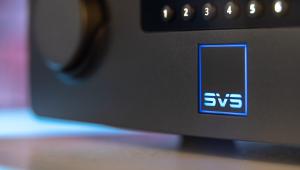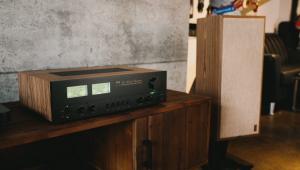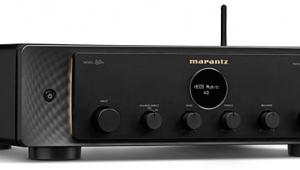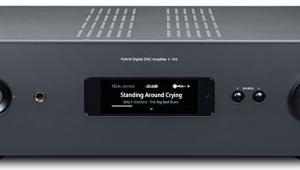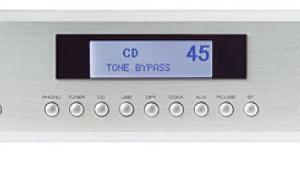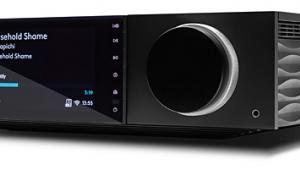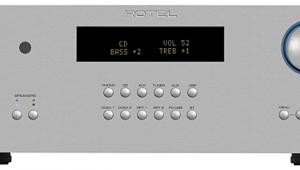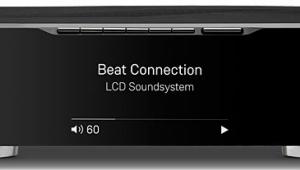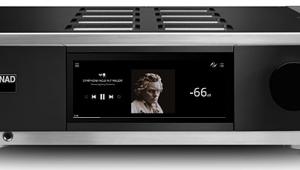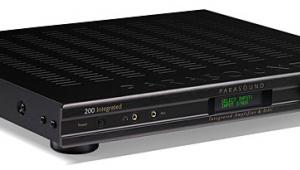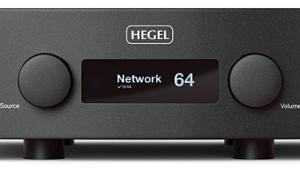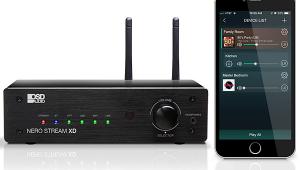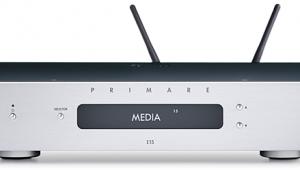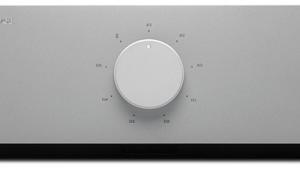Would have loved to hear more with the Debut B4 speakers and S10 sub as the (low-end) setup and then possibly the Ub5 with an S12EQ just for fun. Less than $1,200 for the first and around $1,900 for the second, plus another $1,100 for the Discovery server....OK, I'm just getting silly now.
Elac Element EA101EQ-G Integrated Amplifier/DAC Review Page 2
 EQ for You
EQ for You
Satisfied regarding the Element’s sound quality bona fides, I cranked up Elac’s app on the Android tablet and ran its Auto Blend/EQ routine. This first queries you about the make and model of your speakers and subwoofer, but since the app didn’t bat an eye at my long-discontinued and somewhat obscure Energys, nor at the prototype of a small company’s unreleased new sub that I happened to have on hand, I can only guess at how it employs this data. Next the app prompts you to hold your Android’s mic close to the speaker first, and then the sub, and finally at the listening position, as it determines high-pass (speakers) and low-pass (sub) crossover frequencies, adjusts speaker-sub phase and level, and then adjusts overall speaker/room EQ—all the while drawing graphs representing acquired data, target, and corrected response. It’s visually very cool, but sadly the graphs aren’t saved: Once the routine is complete, they’re gone until the next run.
Auto Blend worked remarkably well. I did three runs with two different subs and sats, and in all cases I was rewarded with impressively wellknit blends, free of crossover-region “thud” and delivered with pleasingly (to me, anyway) conservative initial sub-level settings. (Most auto-setup routines yield initial sub levels that are several decibels too high for my taste.)
Auto EQ’s evidence was less clear-cut. In my room, which is fairly flat/smooth to begin with, its effects were subtle, and in contrast with most room/speaker-EQ algorithms I’ve tried from AVRs and pre/pros, it didn’t seem to “sharpen” or intensify the presence region. It did, however, tighten up, subtly, the 40-to-120-Hz octave-and-a-half—similar to (but, I think, less prominent than) typical runs with Audyssey MultEQ. As always, don’t read too much into this or any other auto-EQ result in one room on one system: way too many variables.
Beyond the setup options, Elac’s app provides basic controls on one screen, with a cool, color, bouncing bar graph of input signal and output levels (the latter, of course, only an approximation). There’s additional drop-down menu access to adjustments for balance, subwoofer level, tone, and input selection. Via another app page, the EA101EQ-G can learn to “map” commands to the keys of just about any other IR remote, so you could use (for example) your TV remote to command volume, mute, and even source-select on the Elac. The routine is similar to those seen on countless soundbars, and it’s straightforwardly prompted by the app’s and the amp’s screen.

The unit’s front-panel display is far too small to be readable across a room, but that’s pretty much my only beef with so simple a design. Interestingly, the Elac decodes Dolby Digital, so you can connect a digital output from a TV or satellite/cable box and get quality sound, albeit downmixed to two channels if it started out with more. I ran a handful of Blu-ray trailers and scenes through this, using all of $575 worth of small bookshelf speakers (stereo pair) and 10-inch subwoofer. The result was outstanding, and I was frankly amazed at how involving and dynamically complete the experience seemed, even without surround or center. I have lots of floor space (and gear), but even so I totally get why Elac included this feature; studio apartment dwellers will no doubt get it even more.
’Phone Fun
Elac even specifies the Element’s headphone output (100 milliwatts at 16 ohms), and indeed the sound via the amp’s 1/4-inch ’phone output seemed superior to the usual run. My ultra-familiar Sony MDR-V6 headphones are one of the better midpriced models of recent decades (and along with the more pro-marketed sibling MDR-7506, they’re a sort of unofficial studio standard). The V6s are fairly sensitive and of undemanding impedance (65 ohms or so); consequently, they did little to stress the Element’s headphone output power. That said, they sounded about as good as I’ve heard them: clean, detailed, highly dynamic and snappy, and just about perfectly honest in tonal presentation. The Elac’s Bluetooth complies with the higher-quality aptX standard, but my iOS Bluetooth sources, alas, do not. Bluetooth via iPhone sounded fine—pairing my iPhone 6 was uneventful—and reasonably clean and quiet. But the Element’s spatial and soundstage finesse, so noteworthy on the better sort of hi-res files and CDs, was utterly gone, and music lost a good deal of life and listening appeal. As a result, a favorite song like Ben Folds Five’s “Army,” whose wire-recorder quality is barely listenable under the best of conditions, fell well below the Mendoza Line. No knock on the Element; to my ears, iPhone/iPad BT does this routinely.

Late in the game, I was able to try the Element’s headphone output on a couple of higher-end “cans”: NAD Viso HP50s (32 ohms), and HiFiMan X-V2s. These both sounded superb, each in its different ways—the NAD’s gorgeously warm-but-controlled bass and the HiFiMan’s dramatic airiness each deserve mention—and the Elac’s output provided plenty of voltage-swing into these lower-impedance designs (32 and 25 ohms, respectively) to maintain full dynamics with full definition, even at unwise volumes. That said, I did now note a residual, volume-independent “tick-over” noise buried in the amp’s floor, way, way down: –100 dB-plus. This was audible, if barely, with a paused digitalinput program, but wholly obscured by any program playing, including recorded “silence.”
I also was able to carry the Element amp over to a long-time industry buddy’s place, to try some different loudspeakers, including some nominally 4-ohm two-ways; it’s no bigger nor heavier than your tenth-grade algebra notebook, after all. We concurred that the little amp’s output remained musical and dynamic into these somewhat more challenging loads, and still delivered ample level for satisfying listening levels in his rather good-sized room.
I loved the sound and the honest real-world power that Elac’s EA101EQ-G delivered, and I judged its feature set to be extremely well judged—Auto Blend wins special mention. The world is awash in subcompact amp/DACs just now, so it’s easy to think of examples less expensive (NAD D 3020) and more expensive (Peachtree Audio Nova150) that deliver proportionate value and performance. Elac aimed at the sweet spot smack in the middle, and they’ve hit the bull’s-eye.
- Log in or register to post comments


